Sharp FQ8 is a television that offers many advantages that distinguish it in its price class. First and foremost, it is equipped with the Google TV operating system, which provides access to a vast number of applications and a user-friendly interface. The matrix with a refresh rate of 120 Hz ensures high fluidity of the image, and combined with low input lag, makes this model a good choice for gamers. The high native contrast means that blacks are deep and vivid. The television also achieves a decent brightness level of 450 nits, allowing for comfortable viewing of HDR content, especially as it supports advanced formats such as Dolby Vision. The television also offers wide color gamut coverage, thanks to the implementation of quantum dots (Quantum Dot/QLED). On the other hand, Sharp FQ8 has a few drawbacks. The lack of control over dynamic tone mapping in HDR mode may be an issue for more demanding users. Although Dolby Vision IQ is present in this model, it's hard to speak of its positive performance here. Additionally, the matrix response time is average, which can affect the clarity of dynamic scenes, and poor viewing angles mean that watching from the side significantly reduces image quality. Nevertheless, Sharp FQ8 is a great television that combines affordable quality and smooth image at a good price. Although it is not without flaws, it can satisfy most users who are looking for a reasonably priced television with a 120 Hz matrix and a pleasant audio system.
- Matching (Score)
- Our verdict
- TV appearance
- Where to buy
- Contrast and black detail
- HDR effect quality
- Factory color reproduction
- Color reproduction after calibration
- Smoothness of tonal transitions
- Image scaling and smoothness of tonal transitions
- Blur and motion smoothness
- Console compatibility and gaming features
- Input lag
- Compatibility with PC
- Viewing angles
- TV efficiency during daytime
- Details about the matrix
- TV features
- Apps
- Playing files from USB
- Sound
C6K / C69K / Q6C

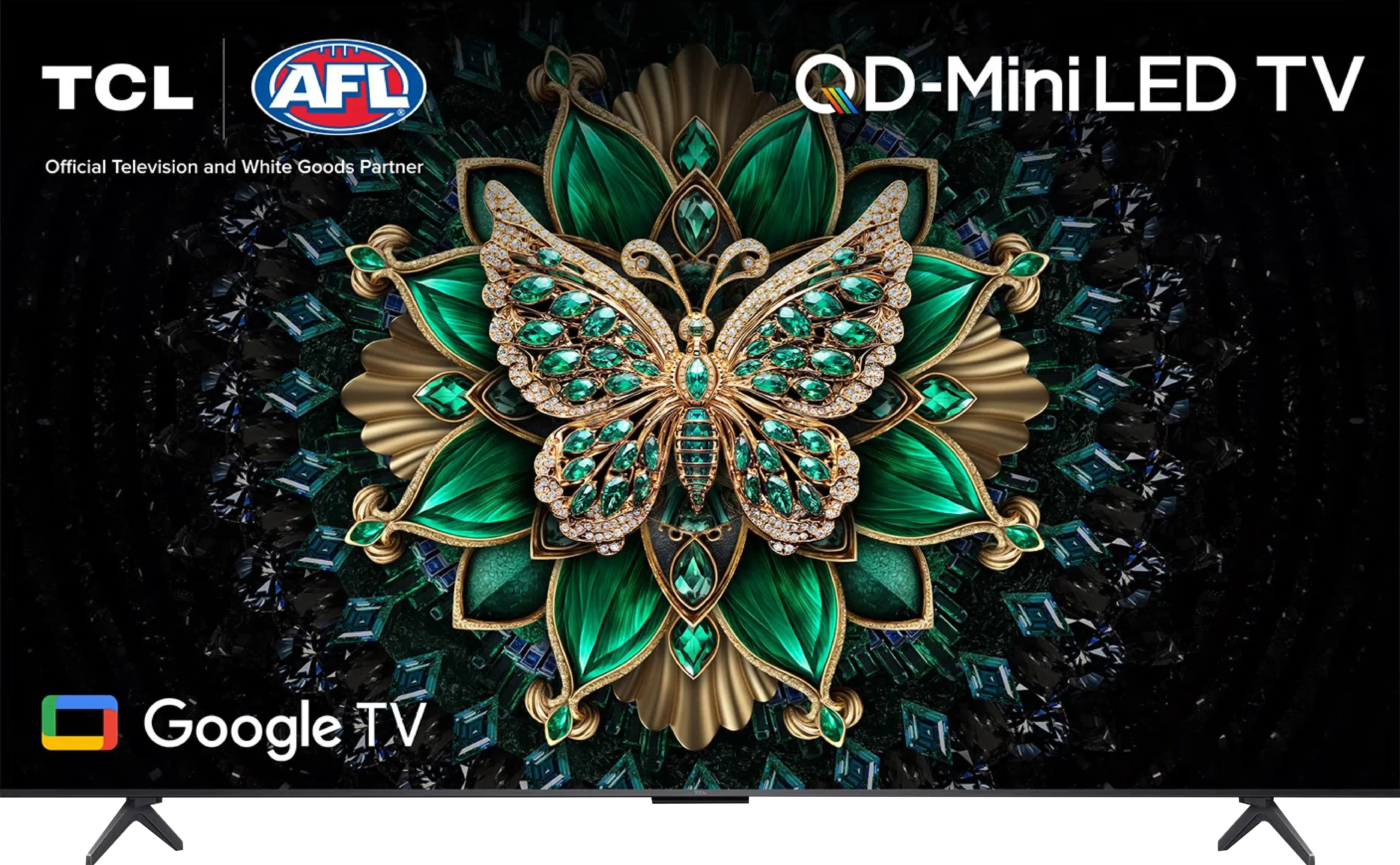
Panel type: LCD VA
Resolution: 3840x2160
System: Google TV
Model year: 2024
Complete the survey to find out the result

Panel type: LCD VA
Resolution: 3840x2160
System: Google TV
Model year: 2025
Complete the survey to find out the result

Overall rating
6.4
7.1
Movies and series in UHD quality
6.4
6.7
Classic TV, YouTube
6.2
6.6
Sports broadcasts (TV and apps)
6.2
6.3
Gaming on console
7.4
8.4
TV as a computer monitor
3.0
8.6
Watching in bright light
5.4
6.4
Utility functions
6.5
7.0
Apps
9.6
9.6
Sound quality
6.0
6.5
Complete the survey to find out what fits your preferences
Advantages
High native contrast
Smooth tonal transitions
120 Hz panel
Advanced features for gamers
Low input lag
Harman/Kardon signature audio
Very good contrast and black: VA panel and MINI-LED backlighting
Good motion smoothness: High refresh rate of 144Hz
Not bad brightness of the panel
Many features for gamers: VRR, ALLM, HDMI 2.1, HGiG
Additional mode for PC gamers: 240Hz
Google TV system with a wide selection of applications
Support for multiple HDR formats including Dolby Vision
Support for Dolby Atmos and DTS
Very attractive price
Disadvantages
Poor viewing angles
Dolby Vision IQ does not work properly
Average panel response time
Poor font readability when connected to PC
Managing the backlighting could be better
Language errors in the system
Our verdict
The TCL C6K is a television for those who want to combine gaming and watching films with good contrast, while not spending a fortune. Thanks to the VA panel with Mini-LED backlighting, blacks are deep, and the contrast is high, making evening screenings truly impressive. Additionally, there is decent brightness, which combined with Dolby Vision allows films to take on a cinematic quality. The smoothness of the picture is also noteworthy – the 144Hz refresh rate works wonders for sports or dynamic games, and gamers receive a full package of extras: VRR, ALLM, HDMI 2.1, HGiG, and even a 240Hz mode on PC. On a daily basis, the television runs on Google TV, which offers a plethora of applications and the Gemini AI voice assistant, making it convenient and flexible to use. It’s also worth mentioning the sound – support for Dolby Atmos and DTS gives the impression that the device is ready not only for gaming. As is often the case, there are a few things that could be improved. The backlighting can lose details or illuminate blacks in challenging scenes, and Polish translations in the menu are sometimes so awkward that one has to ponder what they actually mean. Despite this, the overall performance stands out very well, and considering the price, the TCL C6K could be one of the more interesting choices for anyone looking for a versatile television for films, sports, and gaming. Especially when a good promotion comes along – and when TCL traditionally polishes the small details in updates.
TV appearance




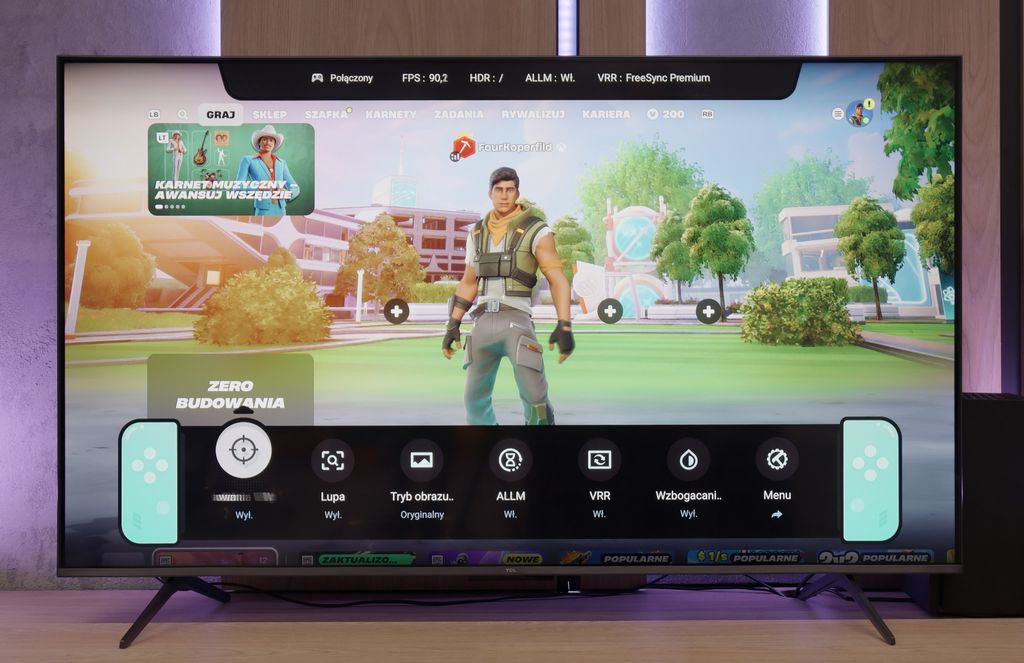
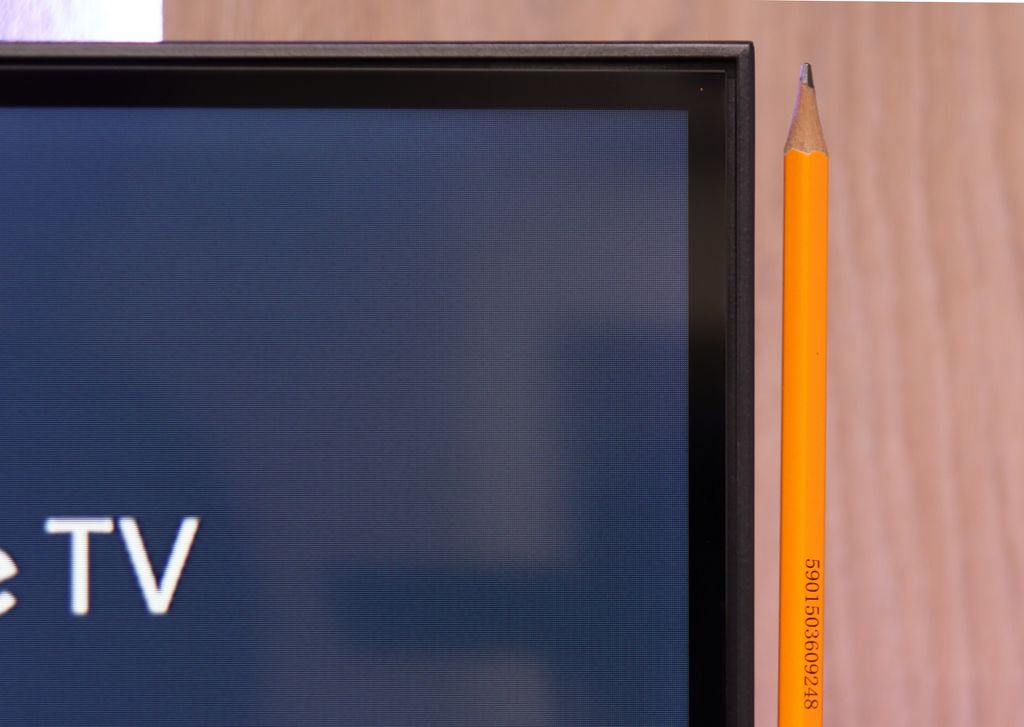
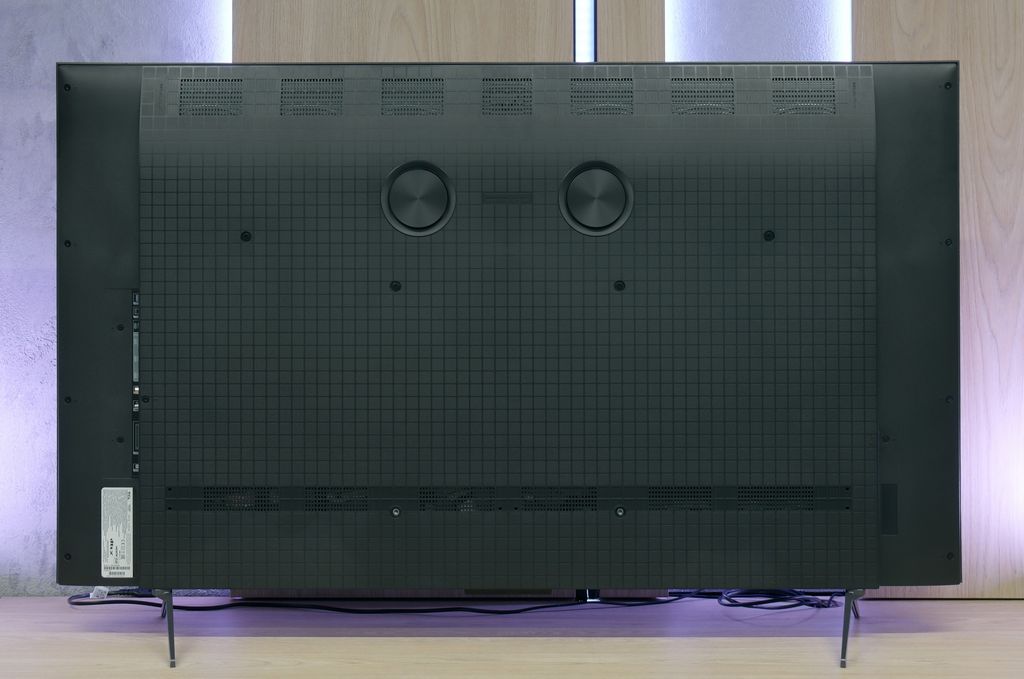
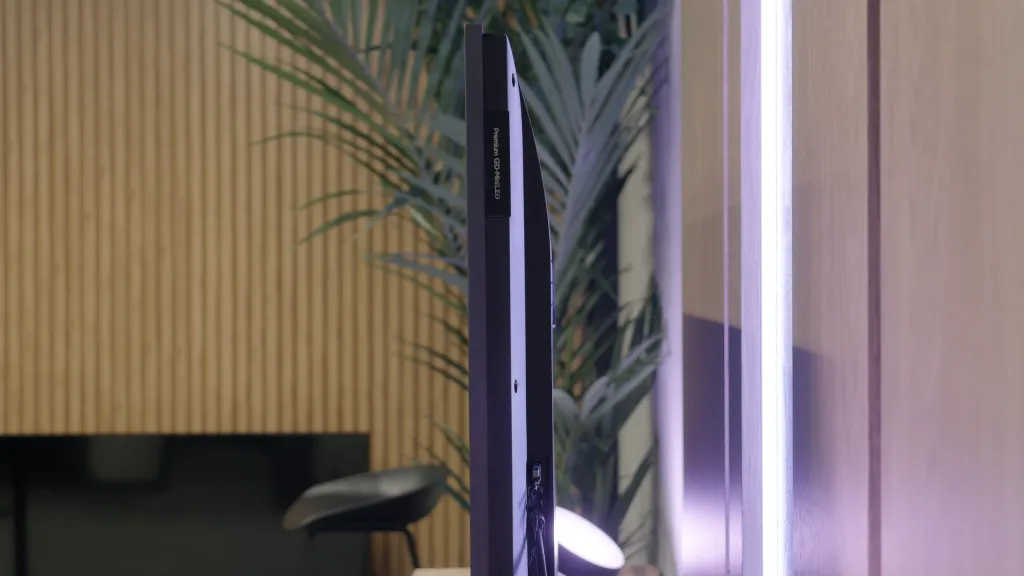
Contrast and black detail
6.2/10
7.3/10
Local dimming function: No
Local dimming function: Yes, number of zones: 180 (10 x 18)
Contrast:

Result
5,200:1

Result
7,200:1

Result
7,700:1

Result
8,100:1

Result
4,800:1

Result
114,000:1

Result
17,300:1

Result
16,200:1

Result
9,900:1

Result
4,850:1
Halo effect and black detail visibility:


Sharp FQ8, thanks to its VA panel, offers a very high native contrast ratio, achieving an impressive score of 8100:1 in tests with cinematic test patterns. It is worth noting that this result stands out very positively against competing models and is very rarely encountered. This means that the image gains an appropriate depth in scenes with distinct differences between light and dark elements, which is particularly important when assessing contrast and black quality, as these are key criteria in image analysis. The Sharp FQ8 panel uses direct backlighting (Direct LED), however, it does not support local dimming. In this price category, this is understandable, although it affects the depth of black and clarity in darker scenes like that from the film Sicario 2, which can be seen below.
The TCL C6K is based on a VA panel, more specifically an HVA manufactured by TCL CSOT, which in itself provides solid native contrast at a level of 6000–7000:1 without the use of local dimming. However, the real strength of this model lies in the Mini-LED backlighting that allows for the dimming of individual zones. In the tested 55-inch version, we counted around 180 of these zones, and with an increase in diagonal size, this number naturally grows. For a television in this price segment, the contrast is truly impressive. In simpler film scenes, such as segments from "Oblivion," it performs excellently, and shots completely bathed in black make a great impression. Of course, due to the nature of Mini-LED technology, it is not always possible to avoid issues – in more challenging frames with many bright details, halo effects may appear or some elements may be dimmed too much (regardless of local dimming settings). Nevertheless, contrast can be considered a strong point of the C6K.
HDR effect quality
5.3/10
4.9/10
Luminance measurements in HDR:

Result
384 nit

Result
399 nit

Result
465 nit

Result
461 nit

Result
463 nit

Result
612 nit

Result
202 nit

Result
424 nit

Result
144 nit

Result
587 nit
Scene from the movie “Pan” (about 2800 nits)


Scene from the movie “Billy Lynn” (about 1100 nits)


Static HDR10


Dynamic: Dolby Vision
Dynamic: Dolby Vision


HDR luminance chart:
TCL C6K
HDR luminance
Sharp FQ8
HDR luminance
Sharp FQ8 can achieve a maximum brightness exceeding 450 nits, which is a satisfactory result. Although it may seem that this value is not impressive, it still places it among the top televisions in this price range. In our opinion, this is also a value from which we will feel the richness of the image and the operation of any metadata, which cannot be said about darker devices. The television supports the advanced HDR format known as Dolby Vision. It is also equipped with DOLBY Vision IQ technology, which stands out for its ability to automatically adjust brightness and image colours based on the lighting conditions in the room. Unfortunately, it has been poorly implemented, resulting in significant inaccuracies such as artificial brightening of the image. Therefore, we do not recommend using this technology in this model. Additionally, the colour gamut coverage is around 94% thanks to the use of quantum dot technology, enabling vibrant and realistic colours. This set of features ensures that the image is not only intense but also full of details.
TCL C6K is a moderately bright television that can showcase its full potential under the best cinematic conditions – the maximum brightness is around 600 nits. In scenes with large, intense light sources, the HDR effect can be truly satisfying, providing a sense of cinematic sparkle. However, it is important to remember that when managing backlight zones, there are occasions where some elements are dimmed, and at times become barely visible. It is clear that there is a lack of proper algorithm optimisation here, although looking at the technical parameters in this price range, the overall construction performs exceedingly well.
Factory color reproduction
4.2/10
5/10


Factory Mode
After calibration


Factory Mode
After calibration
The colour reproduction test in Sharp FQ8 was conducted in film mode, which out of the box offers the best visual capabilities, providing viewers with a colour experience closest to reality. Nevertheless, it cannot be described as exceptional, as there are still some shortcomings that affect the overall picture quality. Colour reproduction in Sharp FQ8 for HD content demonstrates significant issues with white balance. On the graph, the red line clearly rises, indicating excessive dominance of the red colour. This is also confirmed by tests using colour samples, which show that many colours deviate towards red. For example, in a scene from a film featuring a child, the image is very warm and unnaturally red. Similar difficulties occur with 4K HDR content, where there is also noticeable excessive presence of the red colour. It is worth noting this, especially for those who value faithful colour reproduction.
Regarding contrast for SDR, at the beginning of the gamma graph there is a strange characteristic, suggesting issues with reproduction. Subsequently, the entire line is below the reference line, indicating that the television does not achieve appropriate brightness and contrast values in standard content. Meanwhile, the EOTF curve for 4K HDR shows significant discrepancies. Such fluctuations indicate difficulties in maintaining consistent brightness reproduction, leading to unpleasant visual effects when viewing HDR content.
In this year's TCL televisions, the Filmmaker mode has appeared, and it must be admitted that it is definitely the best choice straight out of the box. This is the mode we recommend for daily watching of films and series. Unfortunately, as is often the case, the best does not mean perfect. In the case of SDR content, the image was too warm, as the red was quite pronounced in the white balance. Conversely, with HDR content, we had the opposite impression – the image became cooler than it should have been due to an excess of blue. Additionally, the brightness characteristics sometimes led to overexposure. In practice, this resulted in quite noticeable errors in colour tests, which are difficult to accept in a mode advertised as "from the creators."
Color reproduction after calibration
7.8/10
7.5/10




After calibration, for SDR content, the white balance on Sharp FQ8 has been significantly improved, and all lines have come much closer to the reference line. Of course, they are not perfectly straight, but it's hard to expect better results from a television in this price range; they are really very good. Improving white balance means that colours are more natural and accurately reproduced, which positively impacts the overall visual experience. In terms of gamma, the strange jump at the beginning of the graph has not been eliminated, however, after this error, the entire line is much closer to the expected effect.
For HDR content, the white balance is somewhat worse compared to SDR content, but it is still significantly better than before calibration. It is worth noting that the improvement in white balance in HDR contributes to a more consistent and pleasant perception of colours, even though there may still be shortcomings. Regarding the EOTF graph and the associated contrast, our specialists noted that the lack of control over dynamic tone mapping settings hindered the achievement of significant improvement in this area. This leads to uneven brightness representation.
Despite the shortcomings resulting from the inability to adjust settings for dynamic tone mapping, Sharp FQ8 has gained a new perspective after proper calibrations. The improved white balance and better colour reproduction in SDR mode make the image more natural and pleasing to the eye. Although there are still areas for improvement, especially in HDR content, the television offers satisfying visual experiences, making it a noteworthy choice in its price range.
Thanks to the white balance adjustment, it was possible to significantly reduce the C6K's tendency to distort colours, which translated into a very good final result. After calibration, we will no longer observe the effect of excessive warmth in SDR scenes or overly cooling the image in HDR. However, it is worth taking a closer look at the brightness characteristics. In SDR content, it is difficult to have major objections – the image looks really good, especially in older films, television programmes, or materials from YouTube. It fares much worse in the case of HDR content. An analysis of the EOTF curve suggests that everything is fine, but in practice (EOTF in films), the limitations of the design become apparent. The television tends to over-brighten the smallest parts of the frame, and in other situations, it can dim an entire scene too much. The effect of calibration is therefore evident, and in terms of colour, the C6K has gained quite a lot, but certain limitations arising from local dimming and, in fact, from its management by the C6K simply cannot be overcome.
Smoothness of tonal transitions
8.8/10
9.5/10












When it comes to the fluidity of tonal transitions, Sharp FQ8 television performs excellently, presenting very nice transitions in all the tested movie scenes. Colours blend harmoniously, which significantly impacts the picture quality. The only aspect that can be pointed out is a slightly noticeable gradation towards black and in the scene with a colourful sunset against the mountains. However, these minor imperfections do not detract from the overall positive visual experience that the television offers.
The transitions between colours in the C6K are very smooth, and it is hard to fault any banding. The image looks natural, and any minor imperfections can only be noticed on bright test patterns – and that with really careful viewing. In everyday use, the effect is simply excellent, and one can confidently say that in this category, the C6K performs remarkably well.
Image scaling and smoothness of tonal transitions
6.5/10
5/10
Smooth transition function

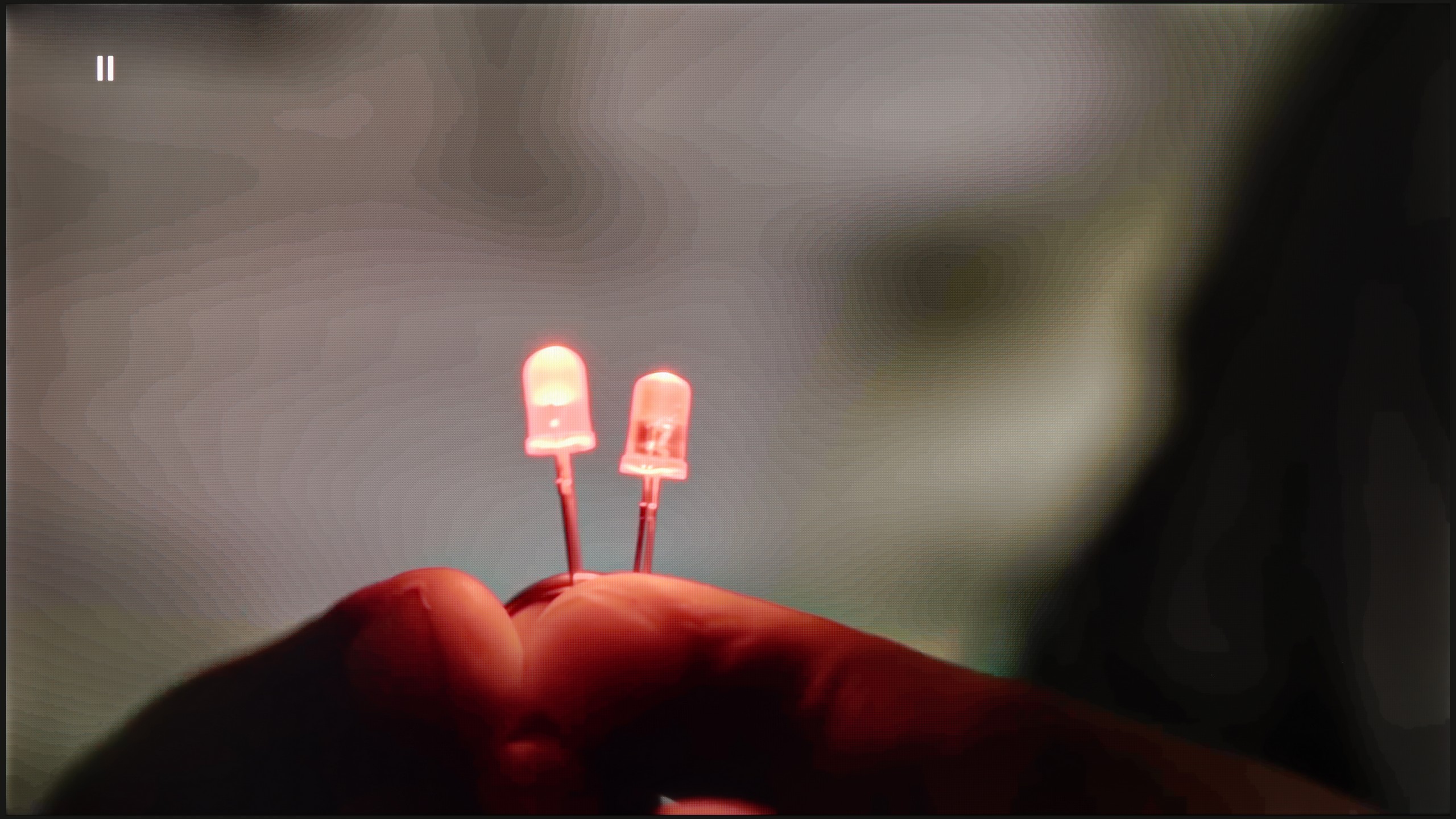
Image without overscan on the SD signal


The "10-bit colour reproduction" feature in Sharp FQ8 performs reasonably well, as we can see in the image with bulbs that shows slight connections between grey shades. For the best results, it is recommended to set medium, which does not reveal issues with grain smoothing or blurring of essential image elements. Alternatively, the "low" setting also proves to be safer and delivers positive effects.
As for upscaling, the Sharp FQ8 television plays back video without overscan, allowing for full use of the screen. The branches shown in the image are noticeably jagged, while the edges of the trousers appear without clear jaggedness, positively affecting the overall image quality. Additionally, the television offers an AI Super Resolution feature, which artificially sharpens jagged elements, enhancing their clarity.
TCL C6K performs quite well in terms of scaling. Lower quality materials look acceptable, and the absence of overscan issues means that the image is displayed in full, without cropping. However, one cannot expect miracles – very low-quality content will not gain a new life here, as the image processor has its limitations. On thin lines or details, there is a noticeable characteristic jerking, which reveals the lack of advanced image enhancement algorithms. It is also a pity that the C6K lacks the feature for smoothing tonal transitions – in older films or video materials, colour banding can be noticeable and can be distracting during longer viewing sessions.
Blur and motion smoothness
7.2/10
7.3/10

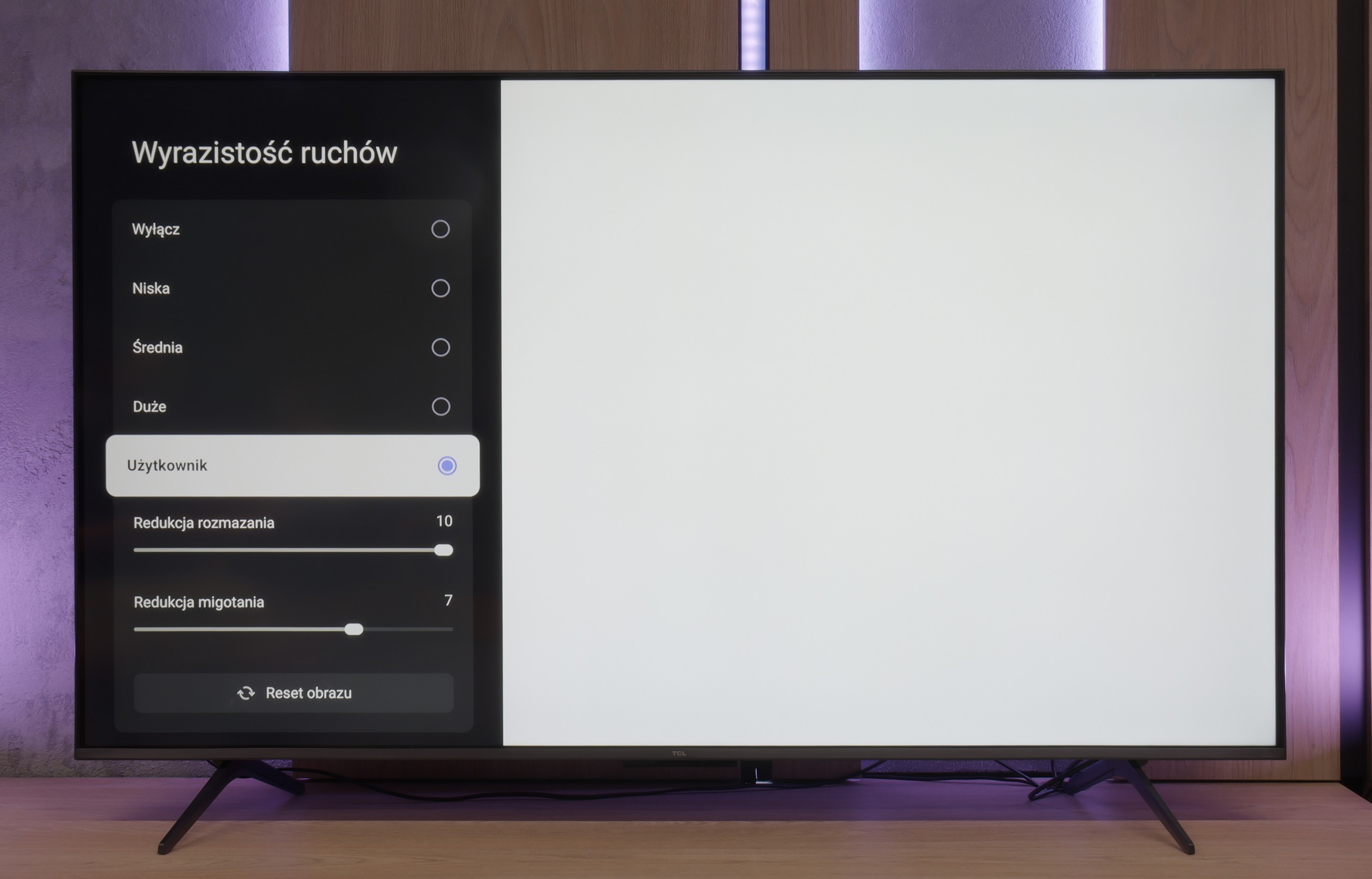
Blur (native resolution, maximum refresh rate):






Blur (BFI function enabled):



Sharp FQ8 is equipped with a 120 Hz panel, with the possibility of achieving 144 Hz on PC, which in theory should translate to smooth motion rendering. The television offers functions for improving the smoothness of films and reducing motion blur, which is important for more dynamic content. However, the lack of Black Frame Insertion (BFI) technology combined with an average response time of the panel does not yield positive results. The effect is slight blurring of moving objects, and this may be more noticeable when watching sports or during intense gaming.
The TCL C6K utilises a 144 Hz panel, which is a significant advantage in this price range. This is an important step forward compared to the previous model, the C655 PRO, which only offered 60 Hz in 4K. The difference is especially noticeable when watching sports or gaming – the ball, players, or fast action in a game are shown more clearly and without losing details. Interestingly, the panel can also operate at 240 Hz, which the manufacturer does not mention in the official materials. We will return to this topic when discussing the PC gaming mode.
TCL has also added a feature for those watching films: "Motion Clarity", which allows users to adjust the image to their liking using two simple sliders. One can either keep the film frame visible or opt for a very smooth, almost theatrical effect. This way, everyone can find settings tailored to their taste.
Console compatibility and gaming features
7.1/10
9.8/10
- ALLM
- VRR
- VRR range48 - 144Hz48 - 240Hz
- Dolby Vision Game Mode
Yes, high input lag
- Correct implementation of HGIG
- 1080p@120Hz
- 1440p@120Hz
- 4K@120Hz
- Game bar

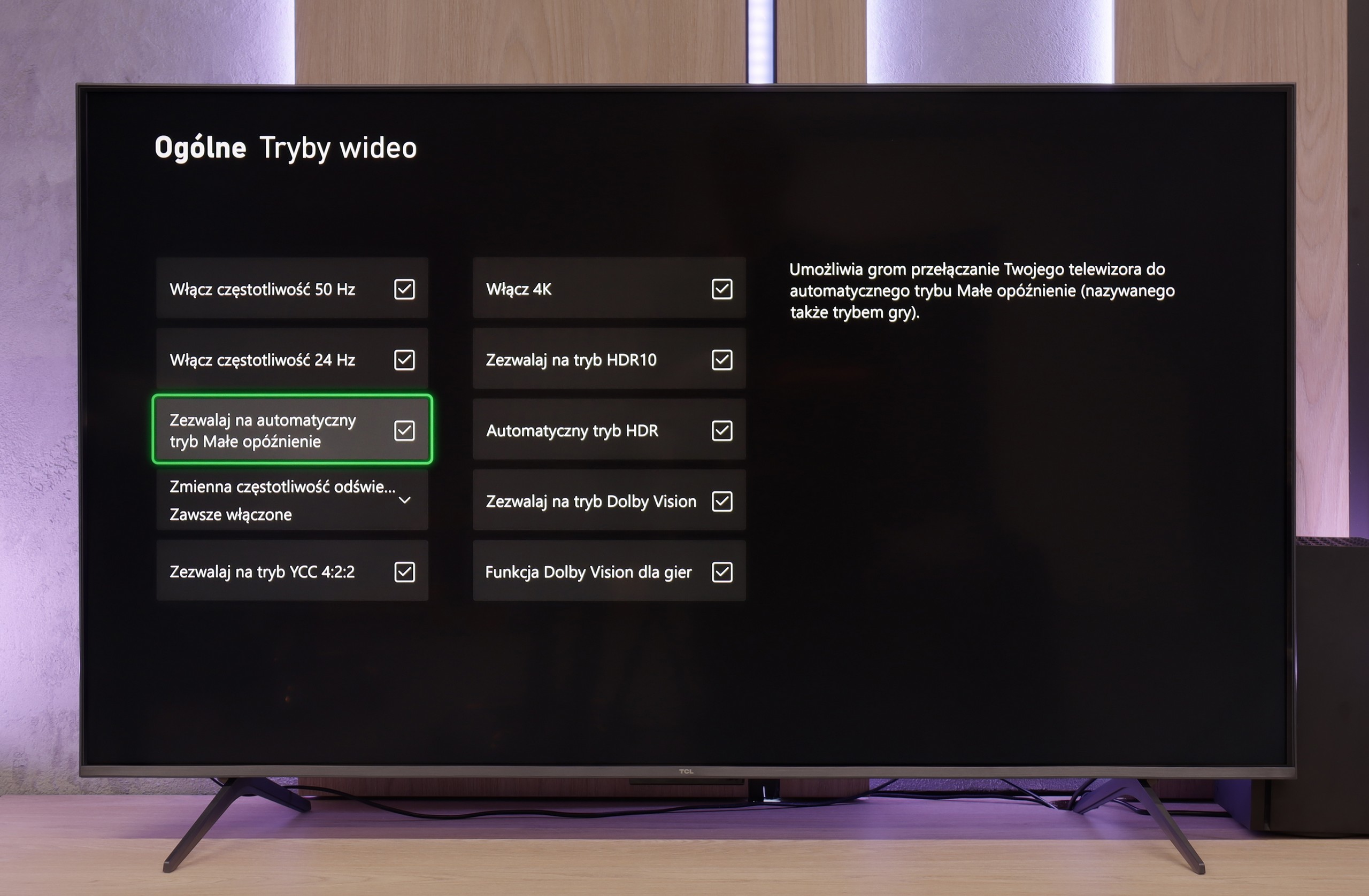

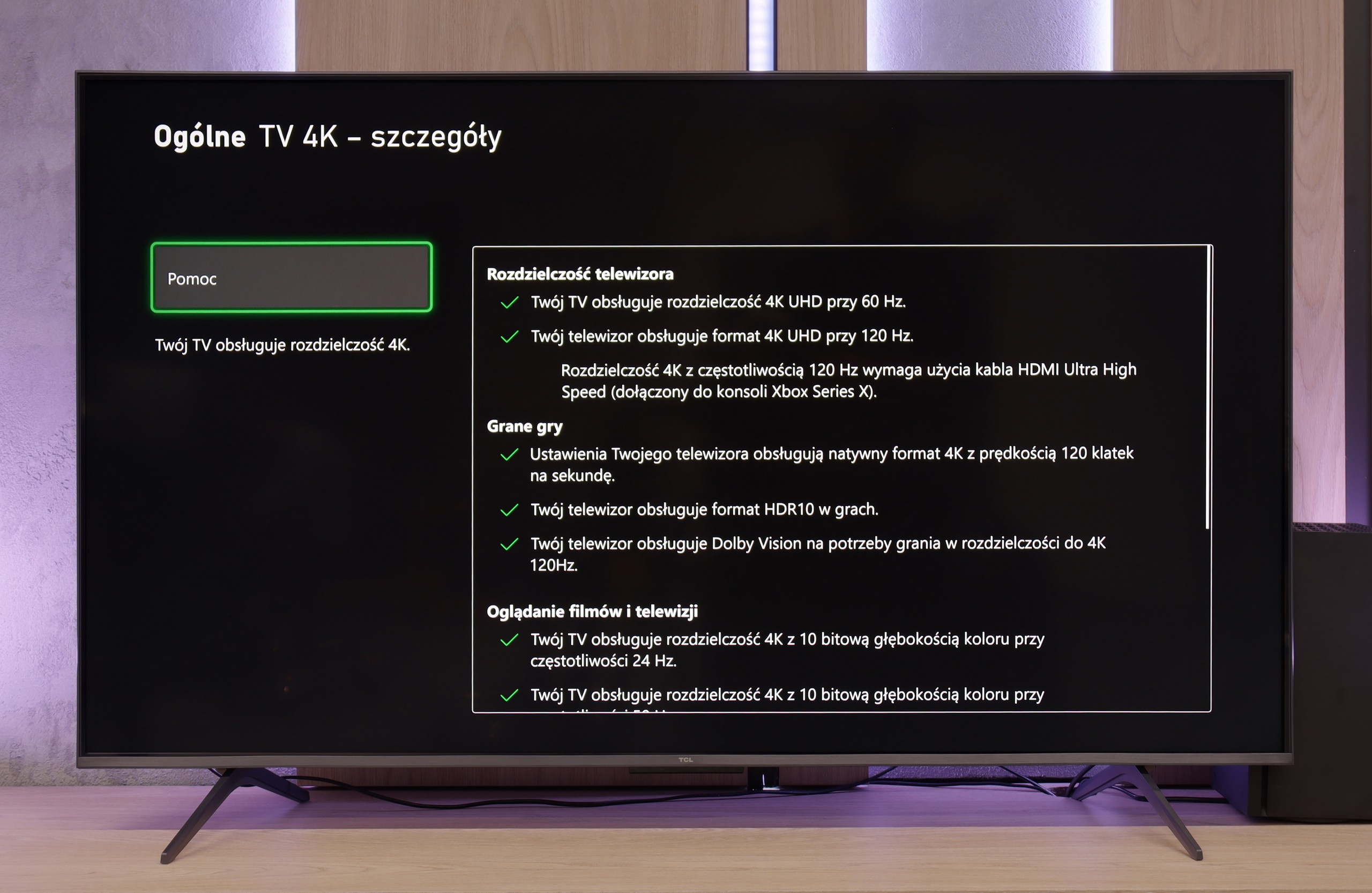

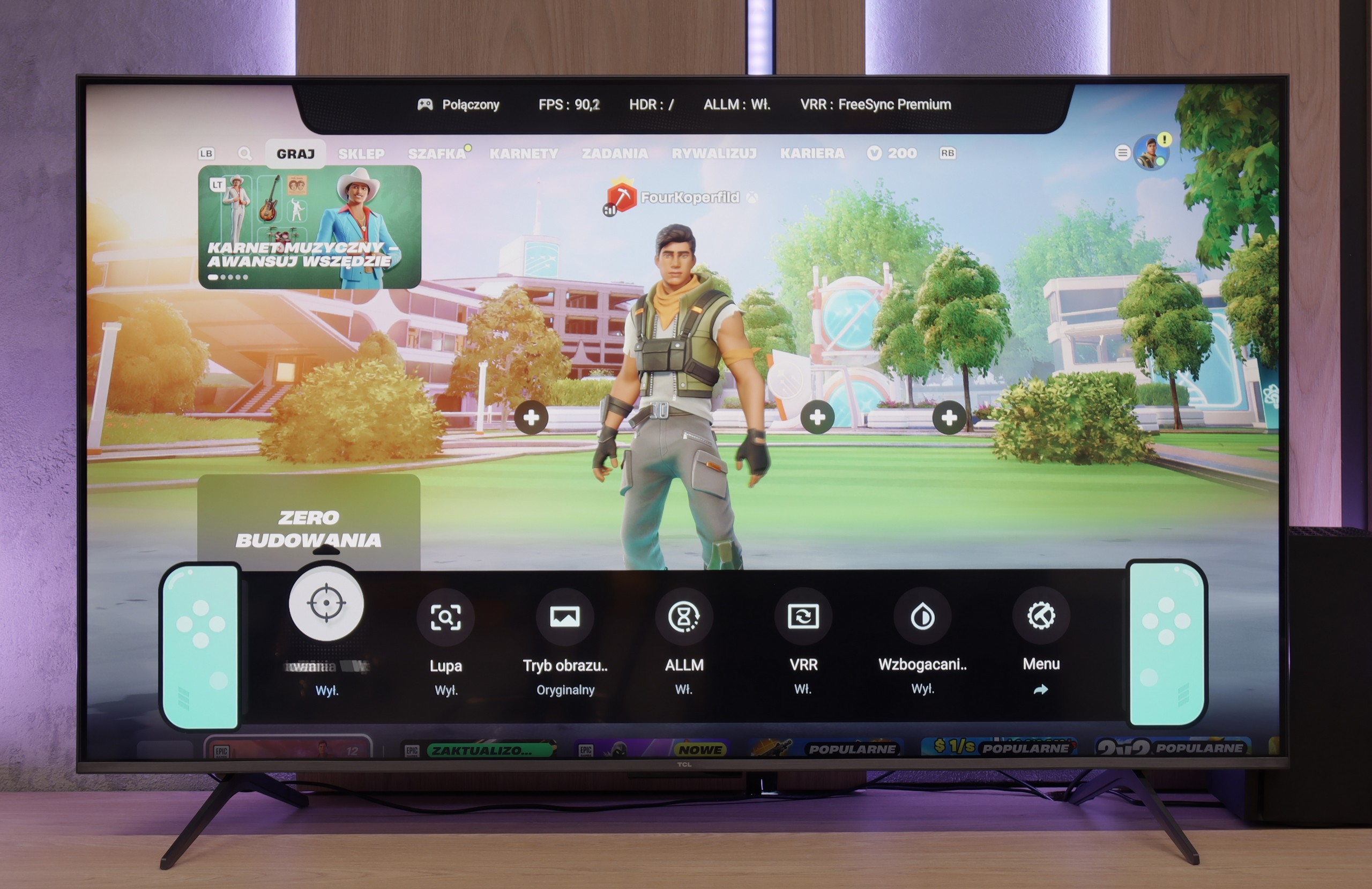

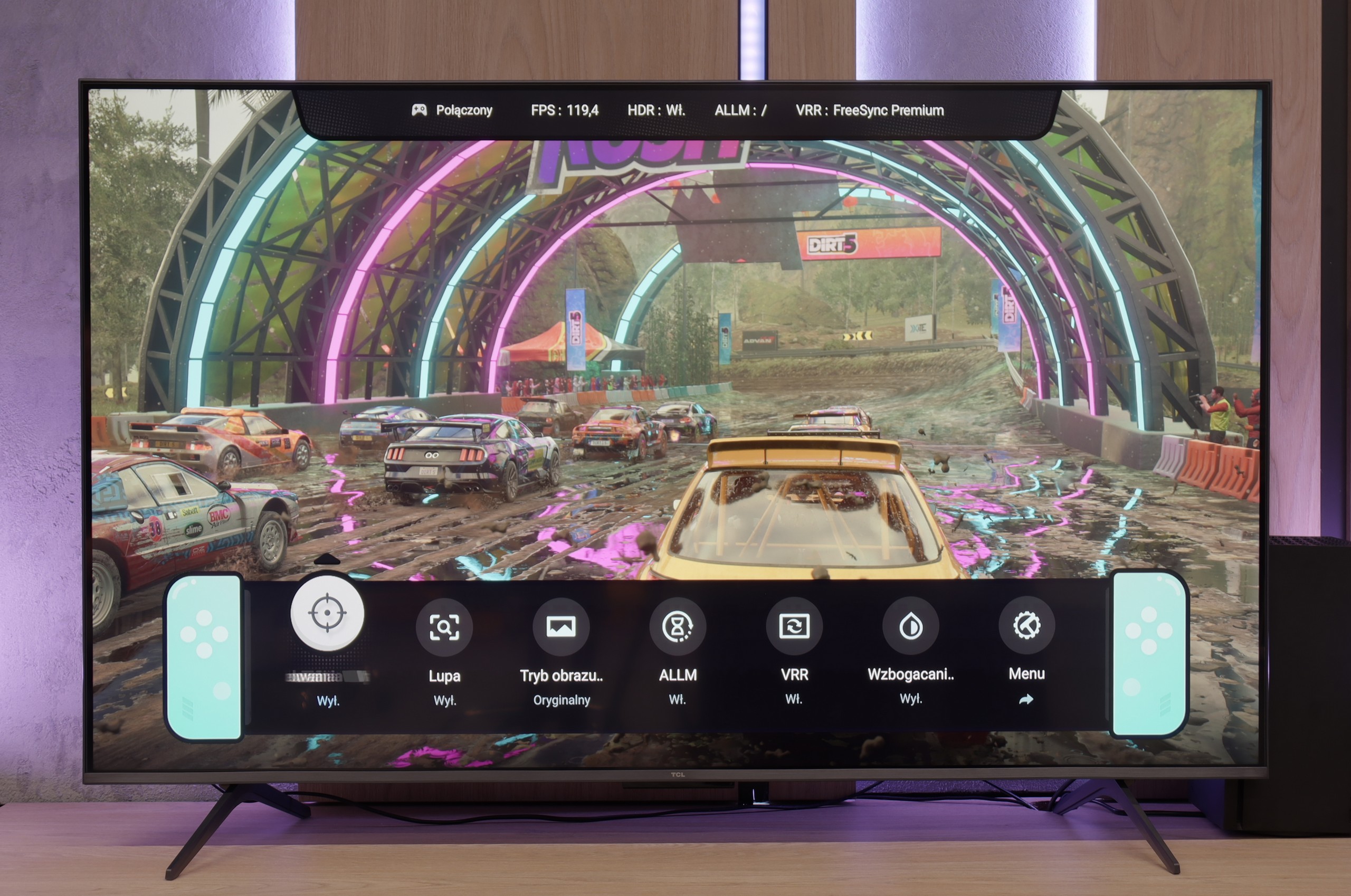
Sharp FQ8 offers several significant features dedicated to gamers that can enhance the gameplay experience. First and foremost, the television is equipped with HDMI 2.1, which comes with certain advantages. ALLM (Auto Low Latency Mode) switches the television to a mode with minimal input lag when a gaming device is detected. VRR (Variable Refresh Rate) reduces screen stutter by adjusting the refresh rate to the number of frames generated by the console or computer, providing smoother experiences, especially in dynamic games. Additionally, the television supports G-Sync technology, which synchronises the image with the graphics card, eliminating stuttering and screen tearing. Despite these advantages, FQ8 also has some limitations. The lack of support for HGiG (HDR Gaming Interest Group) means that the television does not optimise dynamic range for HDR games. The Dolby Vision mode, although theoretically offering better image quality in games supporting this format, suffers from very high input lag.
The TCL C6K is a television that can confidently be described as equipment designed with gamers in mind. Here we have 4K at 144 Hz, VRR support, automatic game mode (ALLM), and Dolby Vision Gaming. Additionally, there is a practical Game Bar, which is a panel with the most important settings easily accessible – useful when we want to quickly change something during gameplay (e.g. screen aspect ratio: Yes, it can be done!). The wide range of VRR is also noteworthy, reaching up to 240 Hz. However, this option is primarily for PC gamers who will drop the resolution below native 4K. At that point, the television can spread its wings and demonstrate extra fluidity, especially in fast-paced esports titles. In the case of consoles, we stick to the classic limit of 120 Hz, but the possibilities are still really broad. The only drawback might be slight ghosting, which can sometimes be seen in dynamic scenes. Apart from that, though, the C6K offers everything that gamers expect from a television.
Input lag
9.1/10
9.7/10
SDR
HDR
Dolby Vision
Generally, the input lag in Sharp FQ8 is very good, achieving below 16 ms for each tested resolution, making the television suitable for gaming, providing smooth and quick response. However, when Dolby Vision mode is enabled and the refresh rate is 60 Hz, the input lag increases sharply. This significantly worsens responsiveness, which can be particularly troublesome in dynamic games where precision and speed of reaction are crucial.
In terms of input lag, the TCL C6K performs exceptionally well. With 120 Hz content, the latency is around 10 ms, and at times even less. This is a level at which the response is practically instantaneous, and it is difficult to find any issues. With 60 Hz materials, the result is around 18 ms – still a very good outcome, entirely sufficient for comfortable gaming.
Compatibility with PC
3/10
8.6/10

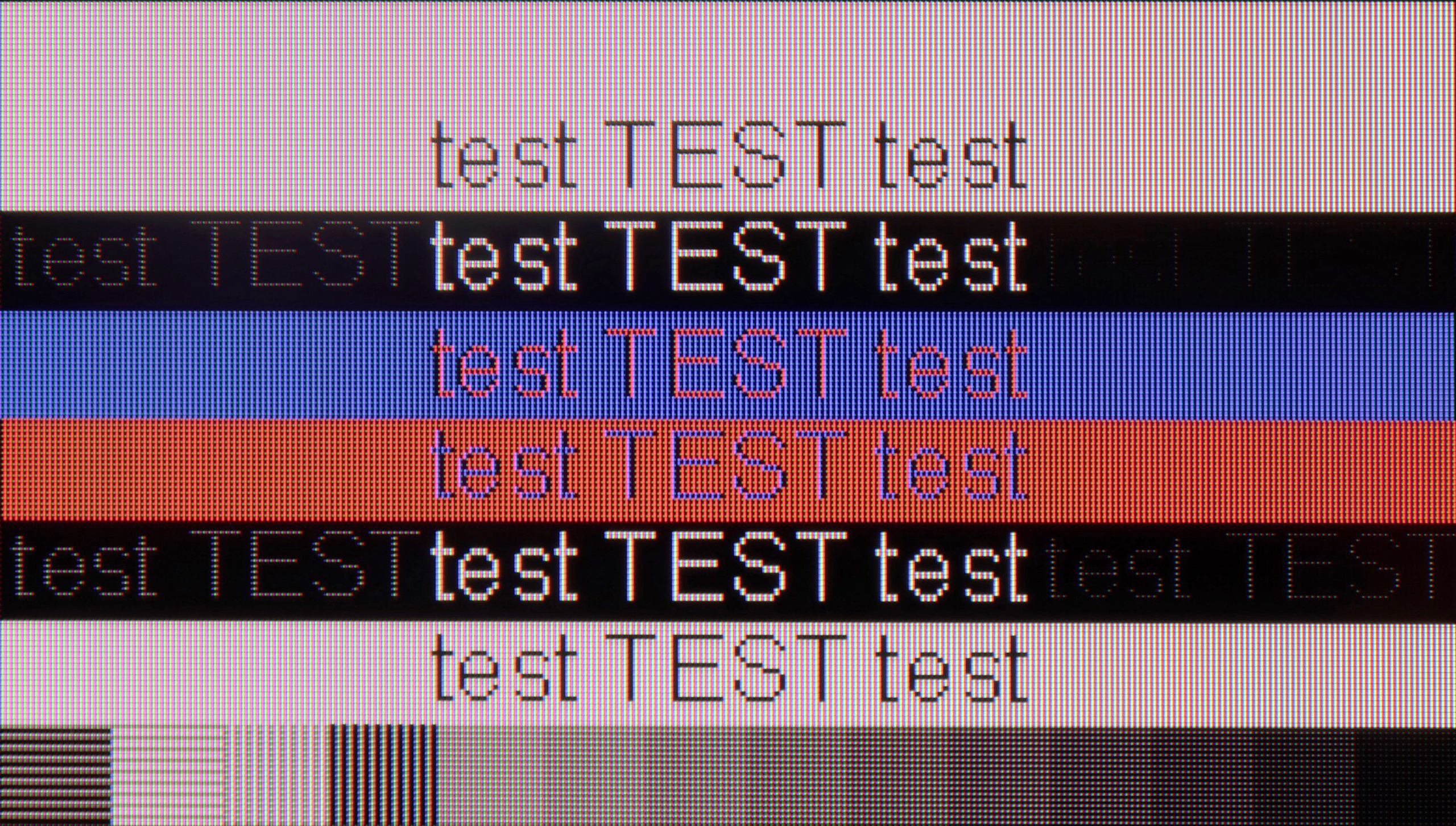
The cooperation of the television Sharp FQ8 with the PC unfortunately leaves a lot to be desired, despite the low input lag. The main problems arise from the lack of full support for chroma 4:4:4 at a resolution of 4K and 120 Hz, which results in blurry text and details in computer graphics. Additionally, the applied subpixel arrangement of BGR, instead of standard RGB, makes fonts less readable and can appear fuzzy.
After connecting to the TCL C6K computer, it performs wonderfully. At its native resolution, we have 4K at 144 Hz, and if we lower the resolution, it can even reach 240 Hz. Additionally, the television communicates well with Nvidia and AMD cards – it supports both G-Sync and FreeSync. It's also difficult to criticise for office work. Fonts are sharp and readable thanks to 4:4:4 chroma support, and any minor imperfections are so small that they simply go unnoticed during normal use.
Viewing angles
2.1/10
3/10
The viewing angles on the Sharp FQ8 are quite poor, which is a result of the use of a VA panel. When watching from a wider angle, the television significantly loses brightness, and colours quickly lose their saturation. As a result, the image becomes washed out, and details less clear, which can be problematic if you plan to watch television with a larger group or from different positions in the room.
In the TCL C6K, the viewing angles are typical for a VA panel. Sitting directly in front, the picture looks very good, but any shift to the side results in a noticeable drop in colour saturation and brightness. The difference is particularly evident in colourful scenes – the hues become washed out, and the contrast loses its depth. Compared to IPS panels, this is a clearly weaker performance, although the trade-off is better black levels and higher native contrast – “you win some, you lose some.”
TV efficiency during daytime
5.4/10
6.4/10

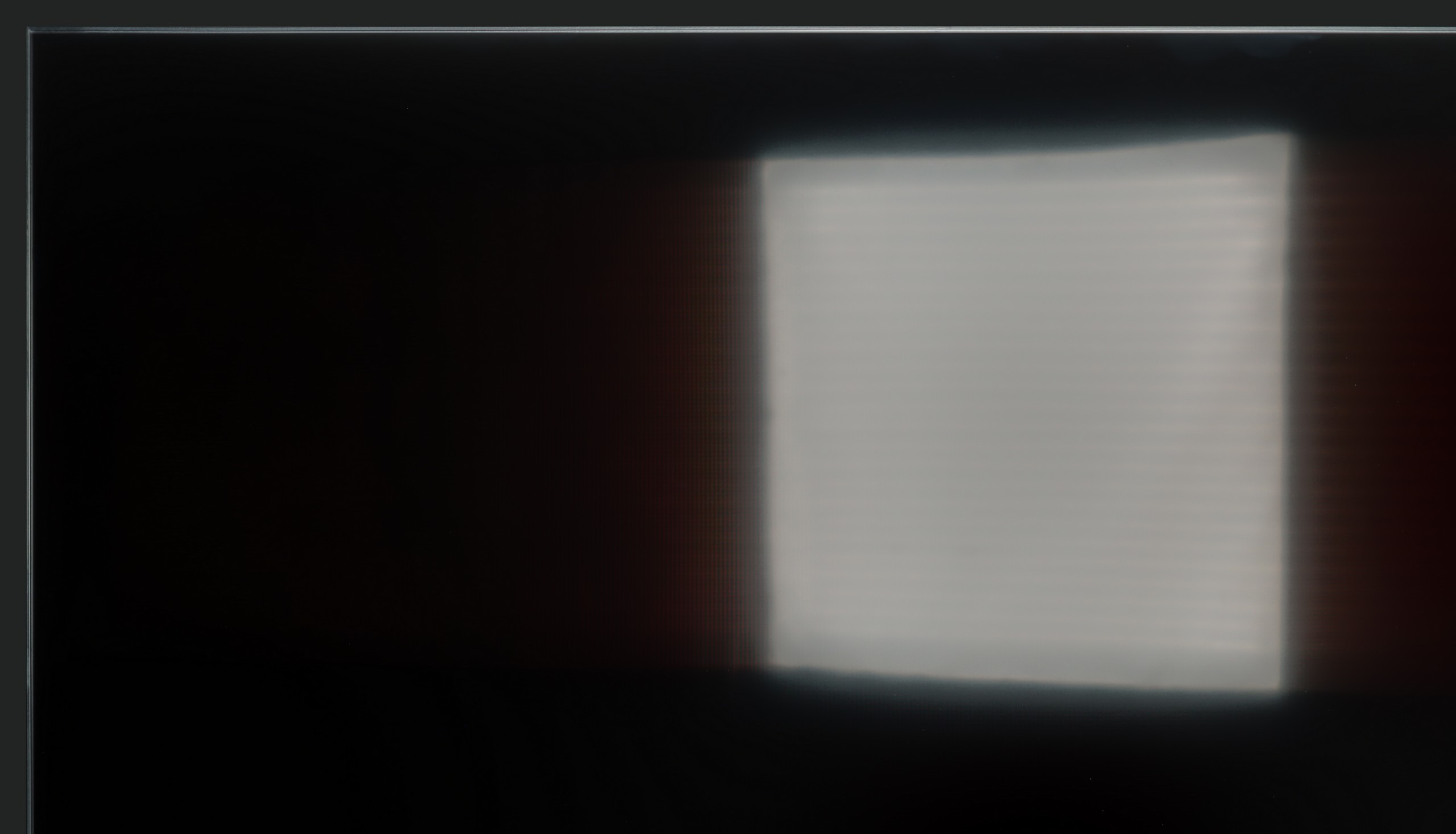


Matrix brightness
Average luminance SDR
TCL C6K: 532 cd/m2
Sharp FQ8: 440 cd/m2
Sharp FQ8 performs quite well in daytime lighting conditions. The panel reaches a brightness level of 440 nits, which, combined with the satin screen coating, results in satisfactory visibility even in bright light. Importantly, the television does not have issues displaying the colour black during the day, which ensures that darker scenes remain readable and do not lose depth, despite the bright surroundings.
TCL C6K performs quite well in bright lighting conditions. The panel offers decent brightness – in SDR content, it reaches around 550 nits, which allows for comfortable television viewing in a moderately lit living room, and even on days with strong light coming through the windows. This means that daytime viewing does not require complete darkening of the room. It's also worth noting that the screen coating does quite a good job of reducing reflections, so the television does not turn into a "mirror" even with strong lighting. However, this is not on the level of top models with more advanced anti-reflective coatings – in very challenging conditions, such as with large glazing, reflections will be noticeable.
Details about the matrix
Subpixel Structure:

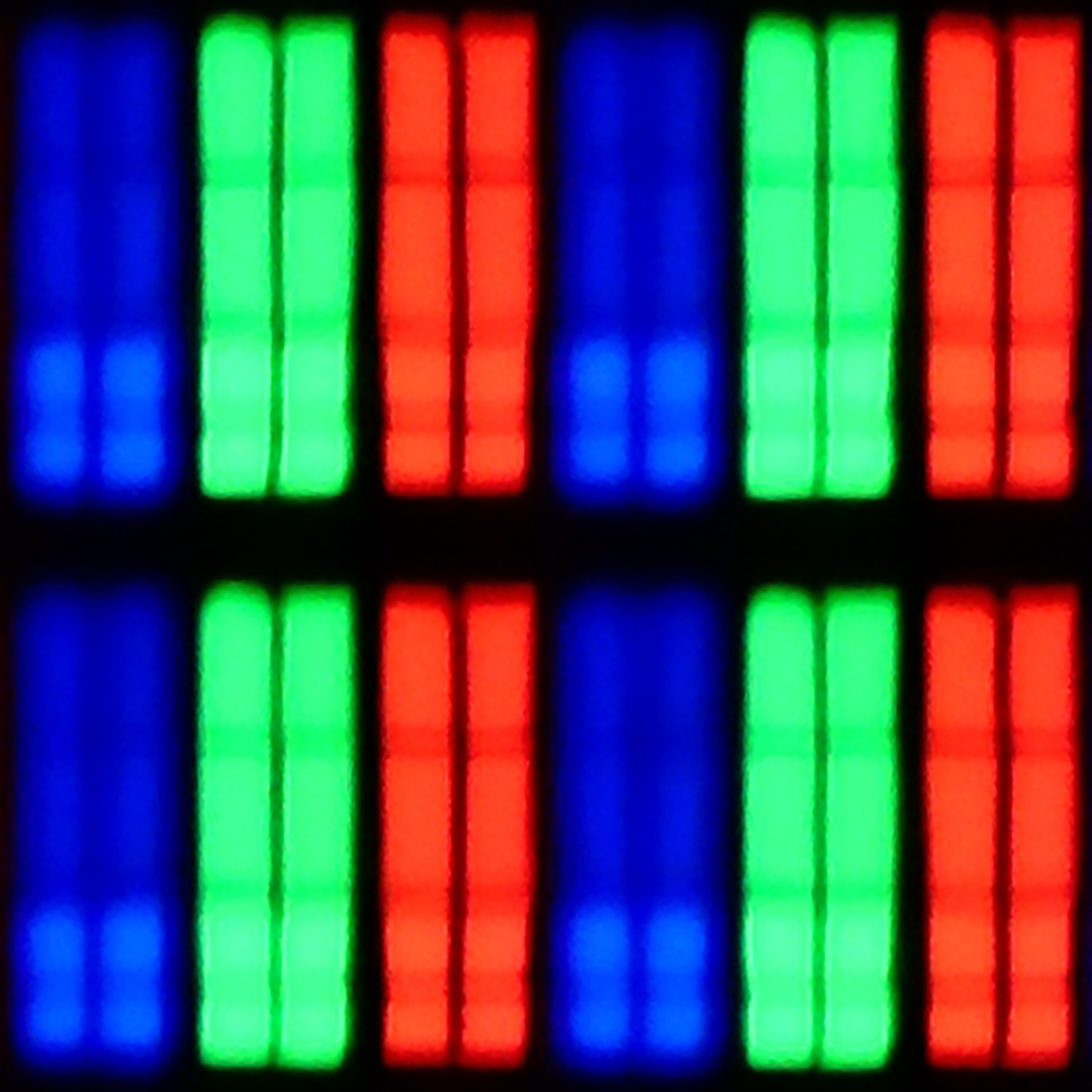
Panel uniformity and thermal imaging:
Sharp FQ8
TCL C6K
TV features
6.5/10
7/10
- HDMI inputs2 x HDMI 2.0, 2 x HDMI 2.1 48Gbps2 x HDMI 2.0, 2 x HDMI 2.1 48Gbps
- Other inputsRCA (Chinch)
- OutputsToslink (Optical audio), eARC (HDMI), ARC (HDMI), Mini-Jack (Headphones)Toslink (Optical audio), eARC (HDMI), ARC (HDMI)
- Network InterfacesWi-Fi 2.4GHz, Wi-Fi 5GHz, Ethernet (LAN) 100MbpsWi-Fi 2.4GHz, Wi-Fi 5GHz, Ethernet (LAN) 100Mbps
- TV receptionDVB-T, DVB-T2, DVB-S, DVB-S2, DVB-CDVB-T, DVB-T2, DVB-S, DVB-S2, DVB-C
Classic features:
- Recording to USB (terrestrial TV)
- Recording programming
- Picture in Picture (PiP)
- RF remote control (no need to aim at the screen)
- Backlit remote control
- Teletext
- Audio only mode
- Bluetooth headphones support
- Simultaneous Bluetooth headphones & TV audio
Smart features:
- AirPlay
- Screen mirroring (Windows Miracast)
- Voice search
- Voice search in native language
- Ability to connect a keyboard and mouse



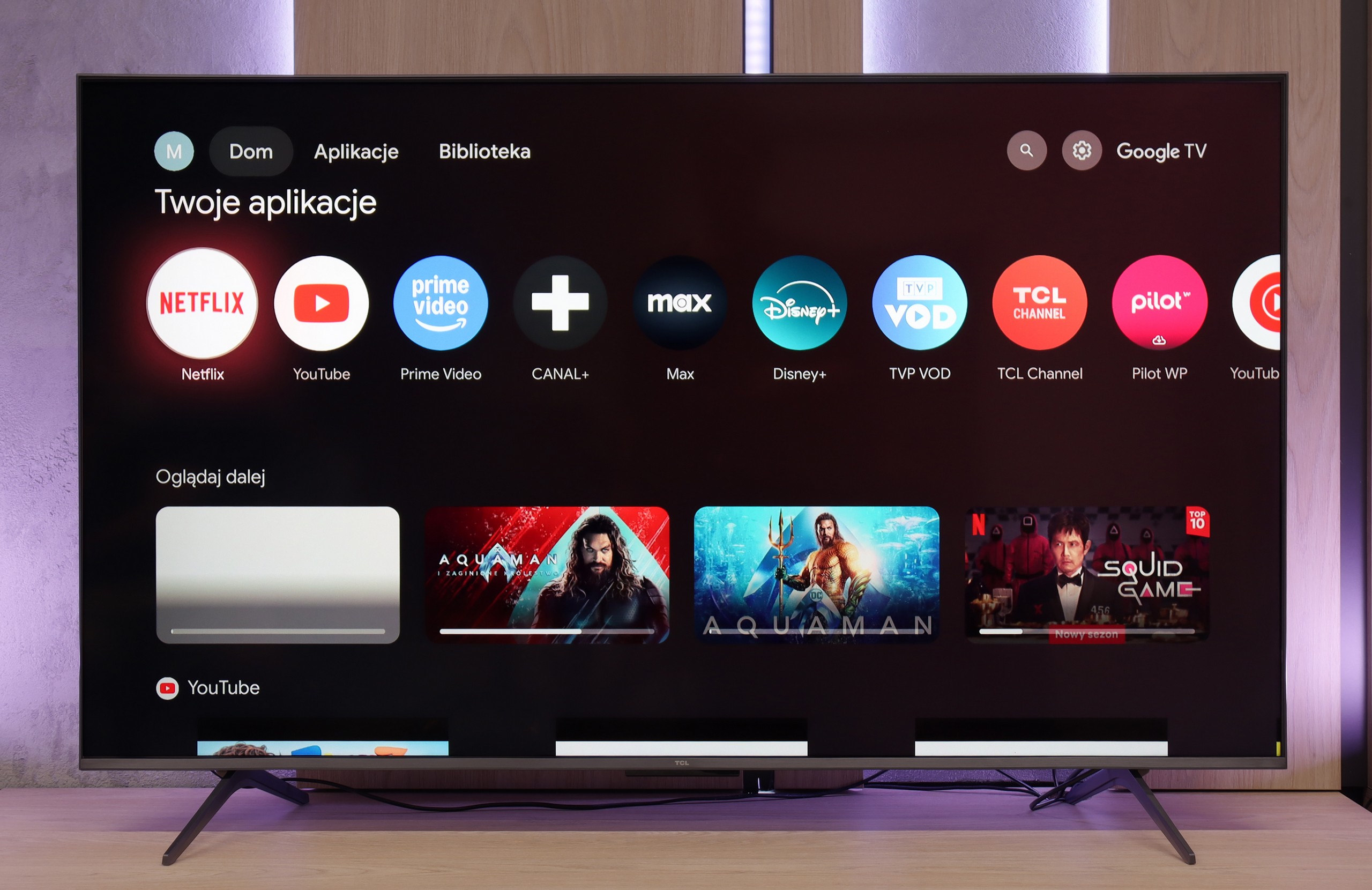
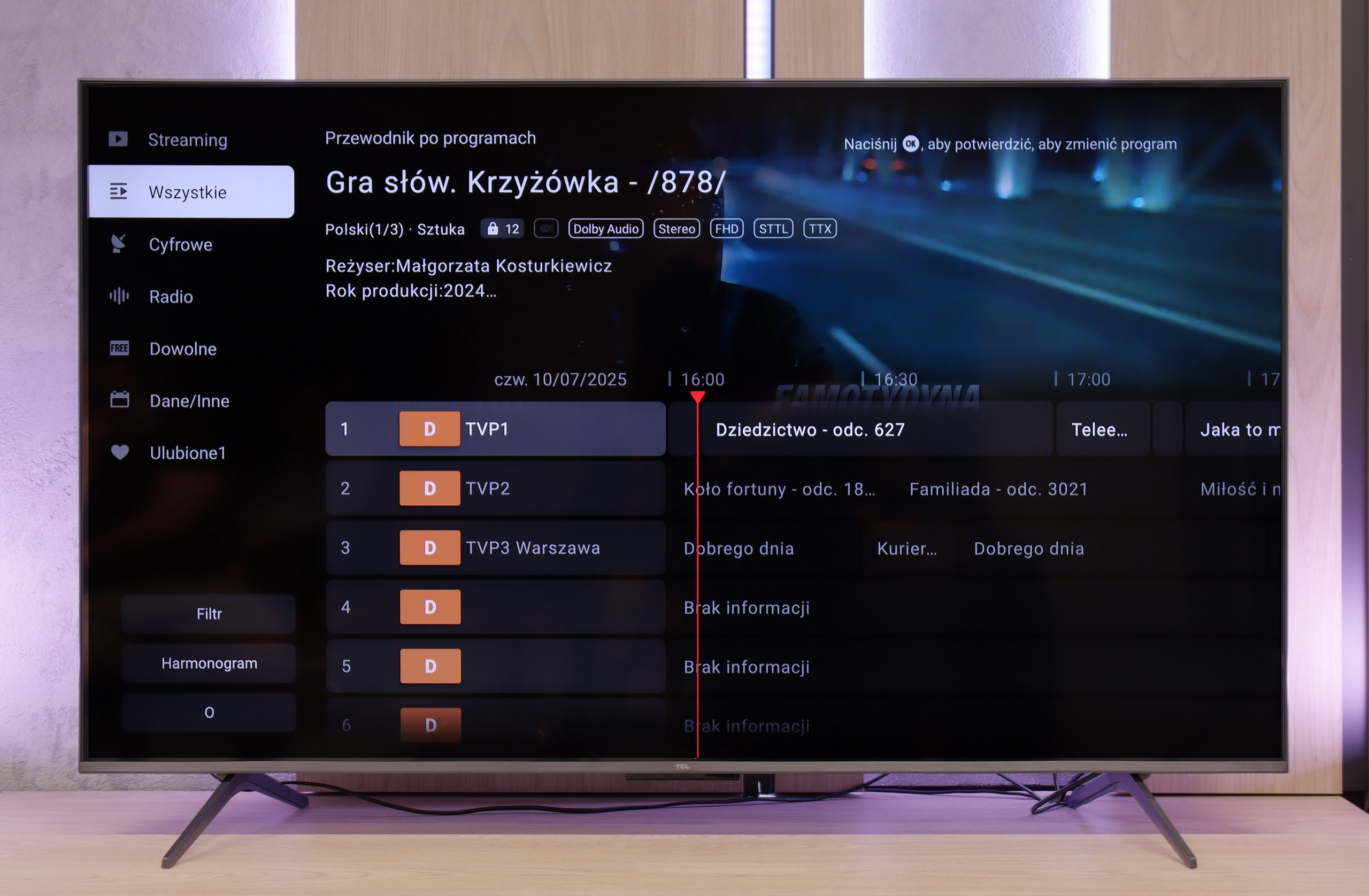
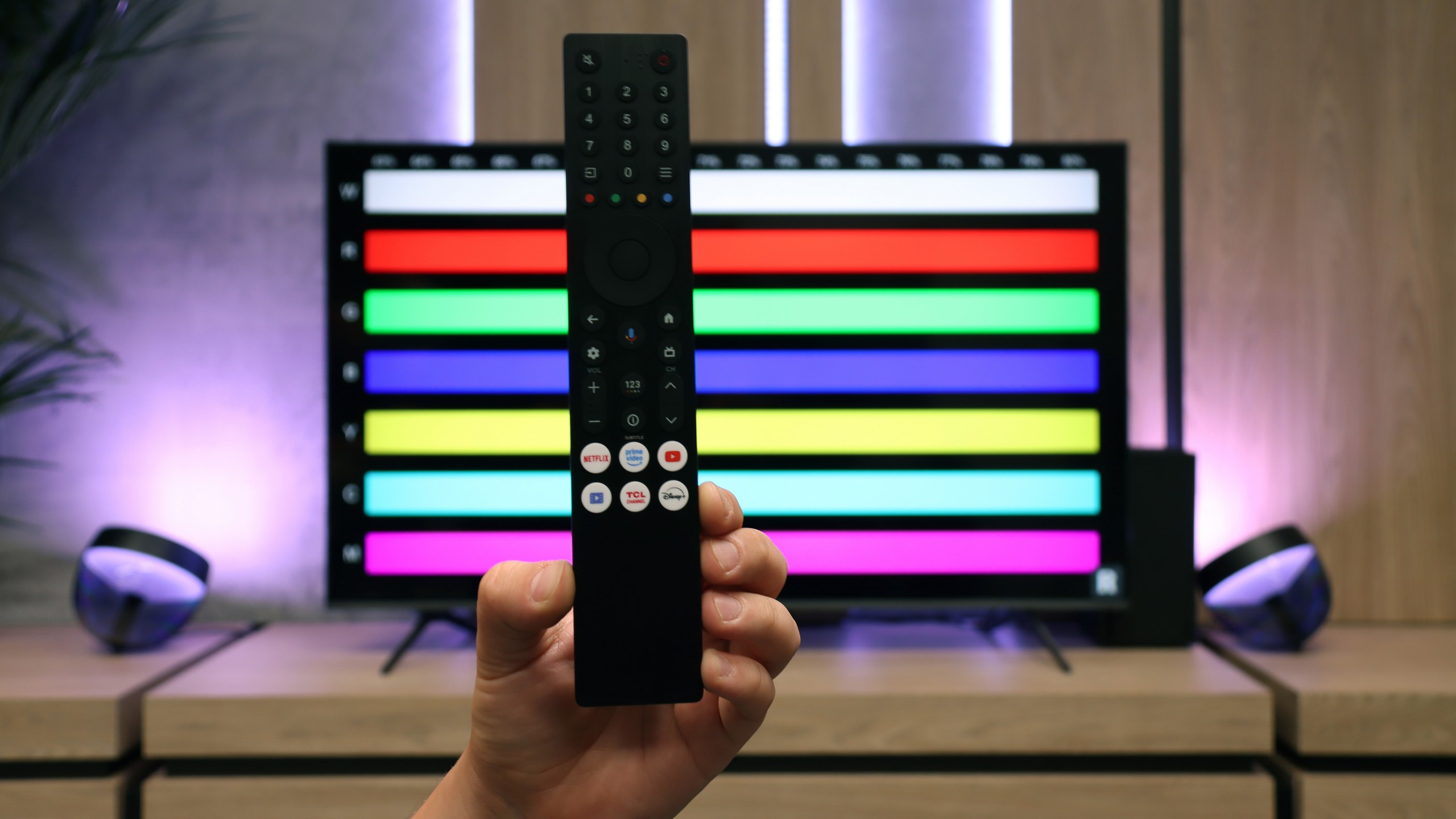
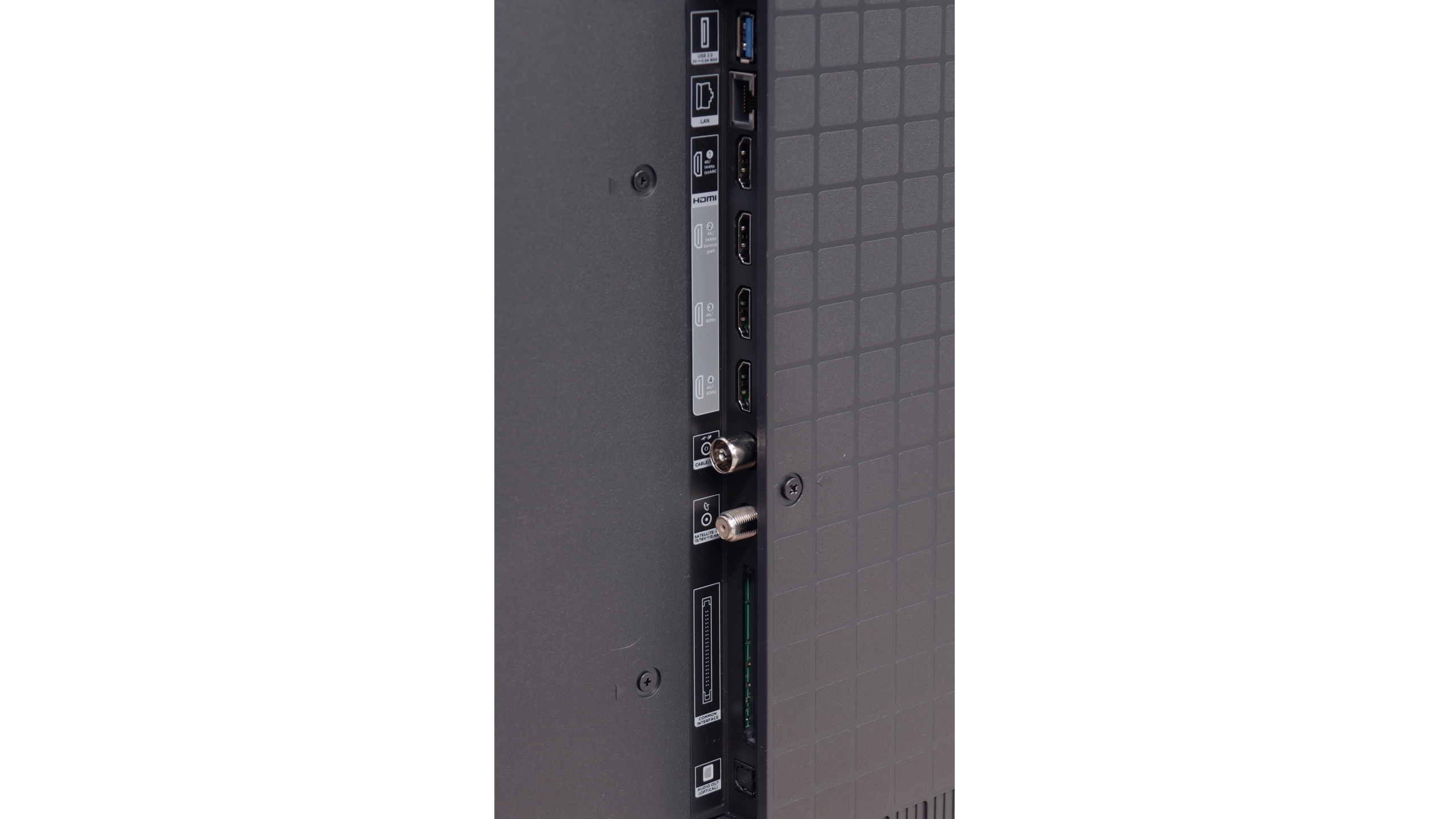
Sharp FQ8 is equipped with a modern Google TV system that provides access to a wide range of applications, such as Netflix, YouTube, Prime Video and Disney+. Additionally, the television supports voice control in Polish, making navigation and quick access to content easier. The FQ8 also offers the ability to connect multiple devices, such as keyboards, mice, Bluetooth headphones, and other accessories.
Despite these advantages, the television has certain limitations. The lack of television recording features and picture-in-picture (PiP) support may be a downside for those using these options. Additionally, Apple device users may feel the lack of compatibility with AirPlay, making it difficult to easily stream content from an iPhone or iPad to the television.
Multimedia Features: Google TV
The strongest aspect of the TCL C6K is undoubtedly the Google TV system. It gives the television character and provides an edge over many competitors. We have a full package of services here – from support for popular streaming apps, to screen mirroring support, and even AirPlay, allowing iPhone users to feel right at home. Additionally, it features Google Assistant (recently with the Gemini AI version), which not only answers questions but also efficiently executes simple commands, such as changing channels or searching for content on VOD services. The system operates quite responsively, although one must mention a certain drawback – the awkward translations in the Polish menu can elicit a smile but sometimes require a moment of reflection to decipher what is actually meant.
Classic Features
When it comes to classic television functions, the TCL C6K performs rather average. There is no USB recording or PiP mode, which may be disappointing for some. However, the manufacturer has not forgotten the basics – teletext television and a clear EPG are available, which still matter to some users. In everyday use, the Bluetooth support for external audio devices is also handy – a simple way to connect a speaker or headphones, which can be a practical solution for seniors. Besides that, it is hard to find elements here that would distinguish the C6K from its competitors – it is simply a solid, but standard package of basic functions.
Playing files from USB
9.4/10
8.9/10
Supported photo formats:
Maximum photo resolution:

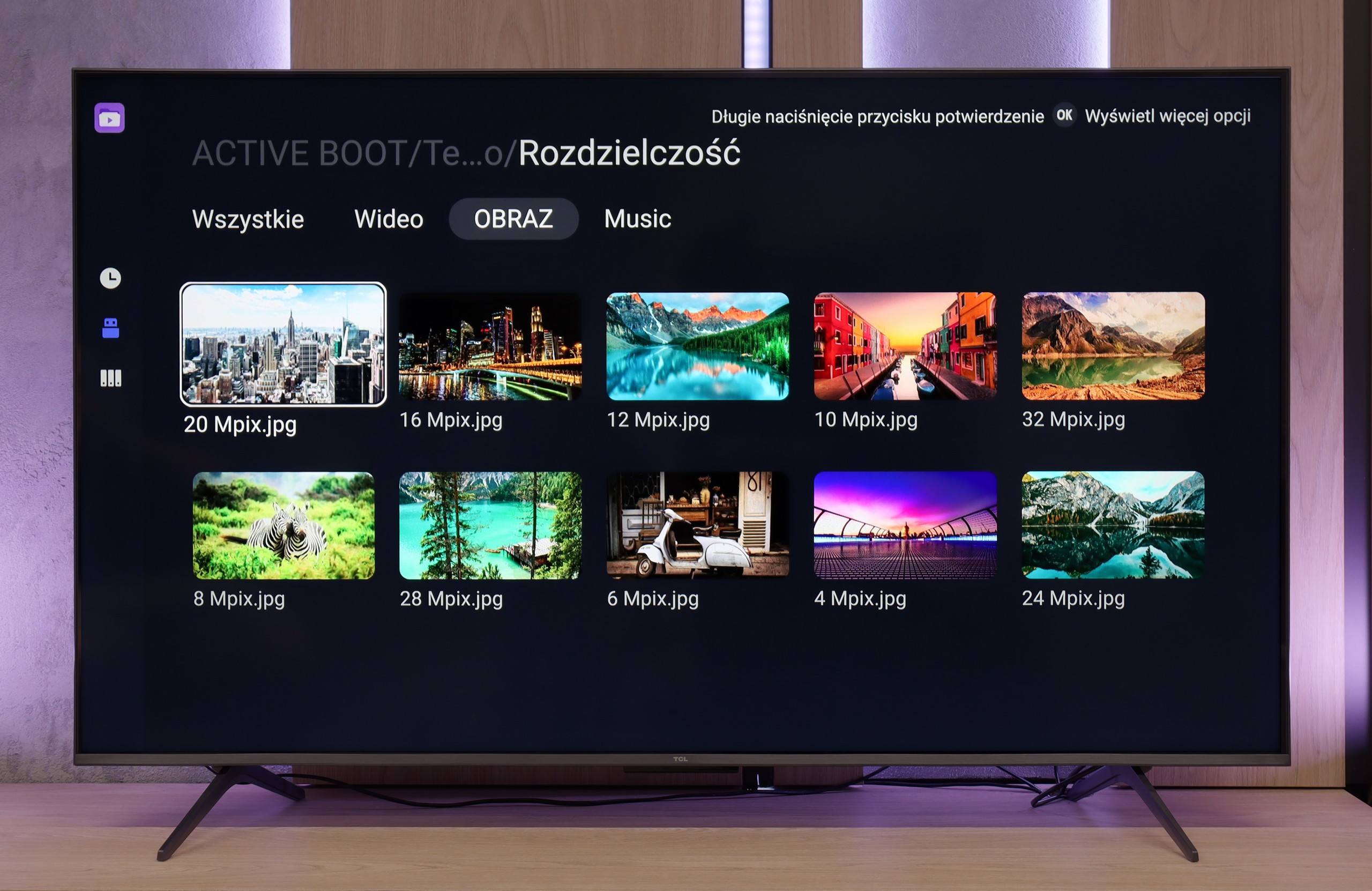
Thanks to the Google TV system, Sharp FQ8 offers great flexibility in playing files from USB. Users can install various applications for image and sound playback, such as VLC or MX Player, which enables the television to handle most popular file formats with ease. Whether it's movies, music, or photos, support for multiple formats ensures comfortable and hassle-free use of multimedia from external storage devices.
The built-in media player in the TCL C6K performs really well - almost all popular file formats work without significant issues. There are indeed minor exceptions, particularly with less common codecs or unconventional video file configurations, but in everyday use, this is rarely noticeable. The biggest advantage, however, is that the television runs on Google TV, which provides complete freedom in choosing additional software. If someone encounters a file that the standard player cannot handle, it's enough to install an alternative - such as VLC - and the problem disappears.
Apps
9.6/10
9.6/10














































Sound
6/10
6.5/10
- Maximum volume91dB-
- Dolby Digital Plus 7.1
- Dolby True HD 7.1
- Dolby Atmos in Dolby Digital Plus (JOC)
- Dolby Atmos in Dolby True HD
- DTS:X in DTS-HD MA
- DTS-HD Master Audio
The sound assessment of the Sharp FQ8 is of course subjective, yet there are a few aspects worth highlighting. The television is equipped with a soundbar directed straight towards the user, branded by Harman/Kardon. Although it is not a full-fledged soundbar or home theatre system, the speaker arrangement clearly enhances the audio experience, delivering a clearer and more direct sound, which will certainly be a beneficial solution for everyday television viewing. It is also worth noting that the television was capable of achieving very high volume levels, which will definitely assist those who have some sort of hearing difficulty. The only remark we encountered was related to the sound processing by Dolby, which caused quite noticeable sound distortions and artificial clipping.
In terms of audio, the TCL C6K performs quite well. The manufacturer has been boasting about its collaboration with the Onkyo brand for several years, and it indeed translates into sound quality. The sound is pleasant, with clear mid-tones and a fairly crisp top end, and overall it feels well-balanced. Of course, it can't replace a full-fledged soundbar, especially in terms of bass depth, but as far as built-in speakers in a television in this price segment go – it's really very good.


